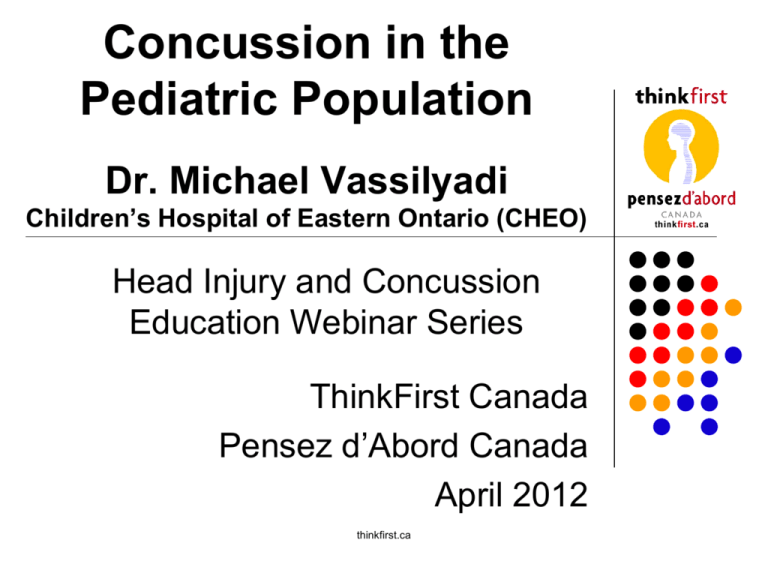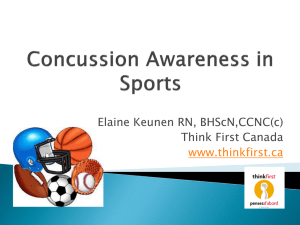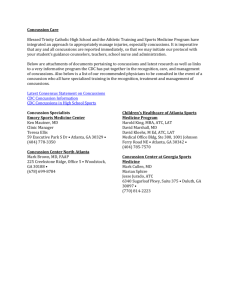Outline for a Concussion Presentation for Teens
advertisement

Concussion in the Pediatric Population Dr. Michael Vassilyadi Children’s Hospital of Eastern Ontario (CHEO) Head Injury and Concussion Education Webinar Series ThinkFirst Canada Pensez d’Abord Canada April 2012 thinkfirst.ca Before we begin… The information contained in this presentation is intended for educational purposes only and is not meant to be a substitute for appropriate medical advice or care. If you believe that you or someone under your care has sustained a concussion we strongly recommend that you contact a qualified health professional for appropriate diagnosis and treatment. The collaborators have made responsible efforts to include accurate and timely information. However the individuals and organizations listed on this website make no representations or warranties regarding the accuracy of the information contained and specifically disclaim any liability in connection with the content of this presentation. thinkfirst.ca Questions to Answer Today: What is the management and return to play recommendations for children with concussions? What are the concerns with concussions? How can I help my child cope and manage with return to life, school and sport? What are the potential chronic symptoms? thinkfirst.ca What is the leading cause of death for Canadians under 45 years of age ? INJURY! Unintentional Injuries and Children Very serious public health issue Imposes a heavy burden on the healthcare system Leading cause of death among children 1-14 years of age Injury accounts for 14% of hospitalizations Second-ranked cause of hospitalizations Unintentional Injuries and Children Most common examples of unintentional injuries are falls, motor vehicle collisions, fires, and poisonings Falls Largest cause of traumatic head injuries among children and youth Occur primarily through sports and recreational activities 300,000 sport-related concussions each year Children and their Brain The brain is surrounded by cerebrospinal fluid, which helps buffer the brain during movements The brain is surrounded by a membrane and encased by a skull with the thickness of 1-2 pennies in children and up to three pennies in adults thinkfirst.ca What’s so special about the BRAIN? The brain is made up of billions of neurons The communications between neurons are how we think, move and feel Neurons don’t grow back This is why PREVENTION is the only cure for Brain and Spinal Cord Injuries thinkfirst.ca Traumatic Brain Injury (TBI) Affects up to 2% of the population/year Major cause of death and severe disability Two causes Impact damage (primary injury) Secondary injury Develops after the impact Progression of hemorrhage, cerebral swelling, decreased brain perfusion because of shock thinkfirst.ca thinkfirst.ca Top Causes of Concussions Females Soccer Horseback Riding Cycling Ice Hockey Snowboarding Males Ice hockey Cycling Football Soccer Snowboarding thinkfirst.ca Sports Related Concussions thinkfirst.ca Concussion and the Brain: What goes on? A concussion affects the brain at the cellular level A blow to the head starts a neuro-metabolic cascade in the brain thinkfirst.ca Concussion and the Brain: What goes on? thinkfirst.ca Concussion and the Brain: What goes on? thinkfirst.ca Summary of Changes at the Cellular Level Injury causes increased energy demand Restricted blood flow and oxygen debt causes an ENERGY CRISIS Exhausted neurons leads to mental confusion and failed memory Brain may take DAYS to WEEKS to restore the chemical balance that constitutes recovery Medical Attention Required when: Loss of consciousness Seizure activity Severe headaches Confusion Nausea/ vomiting Diplopia Neurological deficit thinkfirst.ca Physician Advice with Mild Head Injuries Do not return to play: If there are any persisting symptoms If there are any neurological deficits If there are any diagnostic imaging abnormalities Once symptoms have resolved then may proceed with “step-wise return to play” protocol. Stepwise Return-to-Play Protocol Step 1 Step 2 Complete rest, no activity Light exercise, such as free play, walking or stationary cycling, for 10-15 min Step 3 Sport-specific activity for 20-30 min. (eg., skating in hockey, running in soccer) Stepwise Return-to-Play Protocol Step 4 Step 5 “On field” practice with no contact “On field” practice with body contact, once cleared by a physician Step 6 Game play Concerns with Concussion 1. Second Impact Syndrome 2. Post Concussion Syndrome thinkfirst.ca Second Impact Syndrome Symptoms may be worse Headaches, dizziness, visual impairment, nausea, vomiting, balance problems, etc. There is a period of time that the brain is more susceptible to a second injury thinkfirst.ca Young athletes with SIS are more likely to experience: post traumatic amnesia a disturbance in mental status after each new injury score lower on memory tests The young brain loses its ability to autoregulate its blood supply which leads to vascular engorgement, marked increase in intracranial pressure, brain herniation and ultimately coma and death. thinkfirst.ca Post Concussion Syndrome Collection of symptoms as a sequel to a head injury Contribution of psychological factors Conversion reaction Secondary gain Attention, financial reward, drug seeking,… thinkfirst.ca thinkfirst.ca Symptoms of Post Concussion Syndrome Decreased processing speed Short-term memory impairment Concentration deficit Irritability/ depression Fatigue/ sleep disturbance General feeling of “fogginess” Academic difficulties thinkfirst.ca Concussion in Children vs. Teen Athletes Concussions represent an estimated 8.9% of all high school athletic injuries Data is significantly lacking about concussions in grade school and middle school, athletes Girls are reported to have a higher rate of concussions than boys in similar sports Elementary School Aged Children Continuing development of bodies and brain At this age, connections between the 2 hemispheres of the brain are talking to one another Brain injury during this period may interrupt development of critical cognitive and communication skills thinkfirst.ca If symptoms persist and are left untreated… Teachers and family may notice increased irritability School work may begin to suffer Behaviour may be attributed to factors other than the head injury If the child continues to experience problems, it could lead to depression or “acting out” At risk for academic and social difficulties At risk for further brain injury thinkfirst.ca Stages of Concussive Injury Prolonged Post Concussion Syndrome: Acute Concussion: Physical symptoms (headache ,nausea) Cognitive deficits (memory problems, concentration) Emotional disturbances (irritable, mood swings) Symptoms lasting >6 mos Lower concussion threshold Diminished athletic performance Diminished school or work performance CTE: Post Concussion Syndrome: Persistent concussion symptoms Lasting 1-6 weeks after mTBI Self-limiting thinkfirst.ca Latency period (usually 6-10 yrs) Personality disturbances Emotional lability Personal relationship failures Depression Alcohol/substance abuse Suicide attempt/completion Importance of REST Brain’s response to concussion is to want to rest Rest allows the brain to use available energy to recover Rest allows for symptoms to lessen Use of energy for other activities will increase symptoms and delay recovery thinkfirst.ca Return to School Recommendations Little to no headache Start with half days No immediate testing Limit homework to small blocks of time as tolerated Allow to go to health room to rest if headaches returns Allow to go home if headaches persist Allow for an appropriate time to make up work Possible School Accommodations Decreased homework load Allow for untimed testing as needed Tutoring may be needed with prolong PCS or home schooling Use elevator in school if available Allow to use teacher’s notes or photocopy classmates notes Possible School Accommodations If photophobic, use of sunglasses or hat as needed May provide with pass to leave early from class to avoid crowded or noisy hallways NO Physical Education class Eat somewhere other than cafeteria Prevention Regardless of the steps taken to prevent injury, some athletes will continue to be injured The severity of the injury can be mitigated by the following: 1. EDUCATION for officials, referees, coaches, trainers, parents and athletes to : a. Recognize the symptoms of concussion b. Remove the athlete from play c. Refer the athlete to a physician thinkfirst.ca Prevention 2. Wearing the protective equipment appropriate for the sport engaged in: a. Equipment should fit properly b. Equipment should be well maintained c. Equipment should be worn consistently and correctly 3. Athletes should follow their coaches’ rules for safety and the rules of the sport thinkfirst.ca Prevention 4. Teach your child/teen that it is not smart to play if they had an injury It is not a badge of honour to play injured Discourage others from pressuring injured athletes to play Don’t let your child/teen convince you that he/she is “just fine” 5. Tell all of your child/ teen’s coaches about any concussions they may have suffered in the past 6. Provide reassurance, support and request academic accommodations as needed thinkfirst.ca Concussion Research Project There is a need to both track and manage children with post concussion symptoms One year pilot project Approved by the Research Ethics Board Use of ImPACT program, as well as Neuropsychology assessments when necessary http://www.impacttestonline.com/impactdemo/ thinkfirst.ca CHEO CRP- Referral Criteria Physician referral is required The patient is between the age of 10-17 Injury is sport-related The patient has post-concussion symptoms 3 months post-injury The concussion occurred within the last year thinkfirst.ca ImPACT Test Tool to assess Functional Damage caused by concussion Measures multiple aspects of cognitive functioning in athletes, including: Attention span Working memory Sustained and selective attention time Response variability Non-verbal problem solving Reaction time Used by professional sports organizations, Universities, colleges in the US (over 900 schools) Helps coaches, trainers, doctors, parents and athletes determine when to return to play and with school accommodations Concussion Research Project - Questions 1. 2. 3. What is the severity, frequency and duration of symptoms in children who have sustained a traumatic brain injury while playing a sport and who remain symptomatic greater than three months following their injury? What is the relationship between symptom experience, socioemotional functioning and healthrelated quality of life in this population? What prognostic indicators can be identified for children at high risk for prolonged symptomatology? Pilot Study Findings May 2011 to Present 15 children who sustained sport-related head injuries and remained symptomatic at three months following their injuries, agreed to participate in a Concussion Research Project Approximately twenty other children were assessed but did not meet all of the inclusion criteria for inclusion in the pilot study CRP- Pilot Data n=15 Children ranged in age from 12 to 17 Ten males and five females participated Total number of concussions per patient ranged from 1 to 4, with a median of 2 11 of the 15 patients had at least a second concussion 5 of the initial concussions resulted from hockey (in all but one of these cases a helmet was worn) Others were from gymnastics, martial arts, rugby, BB running, snowboarding (a helmet was worn), soccer CRP- Pilot Data The number of symptoms following the first concussion ranged from 0 to 20, with a median of 10.5, whereas for the second concussion the range was 6 to 23, with a median of 13.5 The number of moderate to severe symptoms following the first concussion ranged from 0 to 19, with a median of 5, whereas for the second concussion the range was 3 to 21, with a median of 11.5. # Pts with Symptoms Mild (%) Moderate To Severe (%) headache 10 13 53 poor concentration 9 20 40 memory problems 8 13 40 sensitivity to light 8 27 27 irritability 7 7 40 trouble falling 7 13 33 poor balance 7 27 20 drowsiness 7 13 13 feeling in a fog 6 13 27 sensitivity to noise 6 13 27 vacant stare/glassy 6 13 27 6 20 20 Symptom asleep eyes feel slowed down Thank You! thinkfirst.ca Acknowledgements Funding Public Health Agency of Canada Grant Content CHEO ThinkFirst Foundation of Canada – Concussion Education and Awareness Committee ThinkFirst Foundation of Canada Staff Elaine Keunen – ThinkFirst Hamilton thinkfirst.ca







